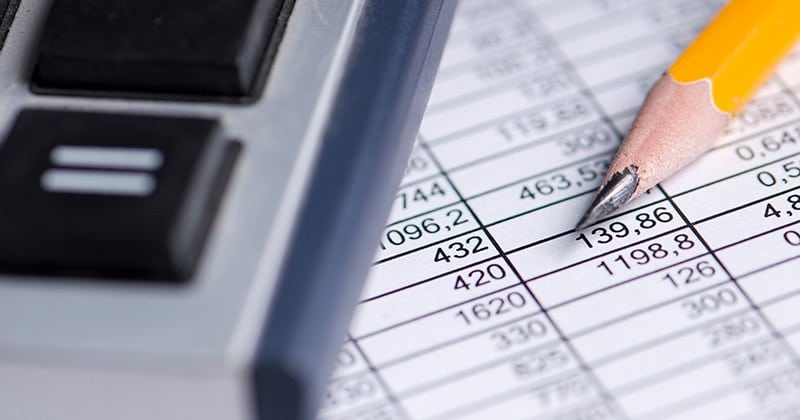Better Bookkeeping for Home Services Companies
Improving your bookkeeping empowers your business to make smart financial decisions. All you need is the right technology, processes, and services, and you’ll be on your way to better bookkeeping.

Staff Contributor
How effective is your bookkeeping?
Whether you have a bookkeeper or rely on software to balance your books, there’s no question that accurate numbers matter.
Bookkeeping problems can leave your home services company struggling to manage cash flow. Cash flow problems impact over half of small businesses and leads to 82% of small business failures in the US.
However, better cash flow management isn’t the only reason good bookkeeping matters. It also guides smarter business decisions.
With robust bookkeeping, you know how to improve your budget. You also can strengthen your finances and set your home services business up for growth. Ultimately, the books financially empower your business.
Are you ready to unlock the power of financial know-how with better bookkeeping?
Read on to find out everything you should know about bookkeeping for home services businesses.
This article covers bookkeeping basics and common mistakes to watch out for. It also provides a quick guide to setting up a bookkeeping system that will support your business’s success.

The Basics of Bookkeeping
What is bookkeeping? Simply put, bookkeeping is the process of recording your business’s financial transactions.
Accurate bookkeeping is a foundational part of running a successful home services business. You need to track every debit and credit so you can:
- Prepare financial statements
- Fulfill your tax obligations
- Understand your company’s financial health
A bookkeeper or accountant uses several documents and tools to keep an accurate tally of the money flowing in and out of your business. The main bookkeeping documents are:
Chart of Accounts
The chart of accounts is a master document for bookkeeping. It lists all the accounts your business tracks in the general ledger.
You’ll use five main account types to build your chart of accounts. These accounts are further broken down into subcategories.
The five main types of accounts are:
- Assets. These are the resources that you can convert into cash. Assets include cash, equipment, and accounts receivable.
- Liabilities. The debts your company owes are liabilities. Loans, accounts payable, and customer credits are examples of liabilities.
- Equity. Equity is the difference between a company’s assets and liabilities. As a local home services business, you probably don’t have shareholder’s equity. But you do have owner’s equity if your assets are greater than your liabilities.
- Income. Sales revenues from products and services are income. Royalties are also considered income.
- Expenses. The amounts your business spends to earn revenue are your expenses. Rent, utility bills, and supplies are all expenses.
General Ledger
The general ledger is the master record of all the credits and debits in the accounts listed in your chart of accounts. It offers a holistic picture of your finances for a specific period.
Income Statement
This financial document compares revenue (income) and expenses. It shows you how efficient your business is at managing money. The income statement is also known as the profit and loss statement.
FROM ONE OF OUR PARTNERS: How to Analyze a Profit and Loss Statement
Balance Sheet
The balance sheet compares the other three main account types: assets, liabilities, and equity. It reveals what your company owns and owes.
Cash Flow Statement
Your cash flow statement looks at cash and cash equivalents. It’s broken down into three categories:
- Cash flow from operations
- Cash flow from investing
- Cash flow from financing
This document is a snapshot of how money flows in and out of your business. It covers a set period of time. For instance, you might create cash flow statements for the year and every quarter.
All these statements work together to paint a detailed picture of your business’s relationship with money—what you spend it on, how good you are at bringing it in, and how effective you are at managing it.
FROM ONE OF OUR PARTNERS: Common Accounting Terms You Should Know

4 of the Most Common Bookkeeping Mistakes in Home Services
Once you have the basics down pat, you are ready to jump into bookkeeping. But instead of going in feet first, take note of the most common bookkeeping mistakes in the home services industry. These are the faux pas you want to avoid.
1. Mixing Personal and Business Finances
A lot of home services entrepreneurs get caught up in marketing and growing their client base. They forget this critical component of good bookkeeping.
You have to separate your finances. Otherwise, keeping track of your transactions is difficult.
Also, you’re more likely to make accounting errors. Even a few simple mistakes can cost you big time. You may have a foggy understanding of business health. You might even face missed tax deduction opportunities and even legal problems.
The solution: Open separate bank accounts. Set up a business credit card. Build business credit.
FROM ONE OF OUR PARTNERS: Reducing Credit Card Chargebacks
2. Neglecting to Track All Expenses
As a business owner, you must track everything. The pens you bought at Target for the office. The money you spent on a photographer for your company’s Instagram. The cost of your bookkeeping software.
If you don’t, you won’t know how effectively your business manages money.
3. Failing to Invoice Properly
Invoicing mistakes can cost your business.
If you don’t send invoices out promptly or aren’t using strategies like late payment fees, you might not get paid on time. That means even though money is coming, you don’t have it in hand. This is exactly the type of scenario that leads to cash flow problems.
4. Ignoring Tax Obligations
Taxes aren’t most people’s favorite subject. But as a small business owner, this is one area you should tackle head-on.
Know what you owe. You’ll need to pay income tax and self-employment tax. Also, stay on top of all your tax reporting and obligations.
You need to do this even if you’re a one-person home services company, such as a solopreneur offering landscaping services or home cleaning.
How to Set Up a Bookkeeping System
As you can see, effective bookkeeping involves more than recording numbers in a ledger. So, to tackle everything, you’ll need a complete system.
Use these four steps to build a bookkeeping system for your small business.
1. Choose the Right Accounting Software
First off, technology. You need accounting software to accurately track your transactions and generate financial documents, like your income statement and balance sheet.
There are plenty of accounting software solutions that can handle everything a small home services business would need.
Most top contenders offer cash flow tracking, invoicing, and time tracking. Some also have helpful features for home services companies, like mileage tracking and estimates.
If you already have field management software in place, you’ll also want to make sure that your chosen accounting software integrates well. That takes some of the effort out of tracking data.
Here are three to check out:
2. Create a Chart of Accounts
Next up—the chart of accounts.
List all the account categories your business uses. You’ll use the five main account types and then relevant subcategories.
Assign a four-digit number range for each account type. For example, number your asset accounts from 1000-1900. Expense accounts might go from 5000 to 5900.
Then, you can create as many subaccounts within those categories as you want. And you can add more as needed.
3. Establish a Bookkeeping Routine
Now that you have your software and master list of accounts, it’s time to roll up your sleeves and get bookkeeping.
Here are some of the tasks that you’ll include in your routine:
- Expense tracking
- Reconciliations
- Payments
- Invoice creation
For instance, you might decide to send out invoices every Friday and pay vendors on Mondays. At the end of each month, you might review your financial statements.
You also might block out two to three hours each month to balance and reconcile your business accounts and compare your income statement to your budget.
4. Hire a Professional Bookkeeper or Accountant
Don’t have time to do everything?
You’re not alone. About 62% of small business owners have an in-house accountant, and many others use outsourced bookkeeping services.
Decide what model works for your budget and your needs. Working with a small business bookkeeper might be enough if you’re a new company. They can handle most of your bookkeeping and advise you to ensure your accounting is up to scratch.
If you have multiple employees and a growing list of clients, you might need to add an accountant to your team.

4 Advanced Bookkeeping Strategies
Once you get rolling, you’ll want to step up your bookkeeping game. Whether you are still DIYing your books or using a pro, you should be familiar with the following strategies:
1. Budgeting and Financial Forecasting
A budget determines how your business should spend money in the near future. You might create a quarterly budget. An annual budget also helps you keep tight control of spending over the medium term.
A financial forecast looks at your current situation and reveals whether you’re on track to meet that budget or not.
Both of these bookkeeping strategies involve looking at past financial trends to determine how to proceed in the best way possible.
2. Tracking and Managing Inventory
You’ll also want to add inventory management to your bookkeeping system if you sell products. You can use software to make this easier. But, essentially, you’ll want to have a system in place, so you always know what your stock levels are and when you purchase new items.
Master this area, and you’ll be able to save money with bulk orders and price negotiations.
3. Implementing Digital Payment Systems
Worried about how much time you spend invoicing and paying vendors?
Go digital. If you’re still using paper invoices and manual tracking for accounts payable and accounts receivable, it’s time to modernize.
Fortunately, most bookkeeping service software will sync with your digital payment system. All you have to do is link your payment processor and business accounts to your accounting software.
FROM ONE OF OUR PARTNERS: How to Protect the Financial Data of Your Small Business and Your Customers
4. Automating Bookkeeping Tasks
With today’s technology, almost every manual task can be automated. Payment reminders. Expense tracking. Financial document generation.
If you’re doing it by hand, chances are good that your software can do the work for you. You can use an all-in-one accounting system. Or, you can opt for standalone apps to handle specific tasks, such as spend management or receipt uploads. Then, integrate them with your accounting system to ensure you have a single source of truth.
3 Ways to Boost Your Bookkeeping Now
Better bookkeeping is just around the corner. You can set up an effective system with the right software in a few days. It also won’t take long to develop your bookkeeping routine or find a good accountant to work with.
There are also a few things you can do right now to jumpstart your financial management.
1. Dust off your budget
If you already have a budget, pull it out. Make sure it’s up to date.
2. Create automatic reminders
Set reminders in your phone or online work calendar so you remember to stay on top of your daily, weekly, monthly, and quarterly tasks.
3. Make a checklist
List all your bookkeeping to-dos—finding software, separating your accounts, ensuring you’re tracking everything. Give yourself a deadline for each task, and make your journey to better bookkeeping manageable.


